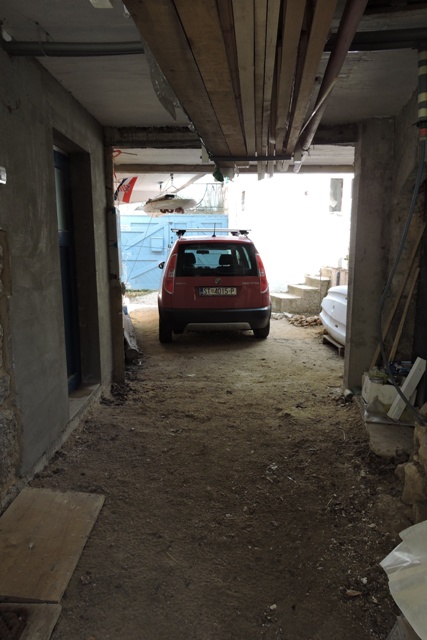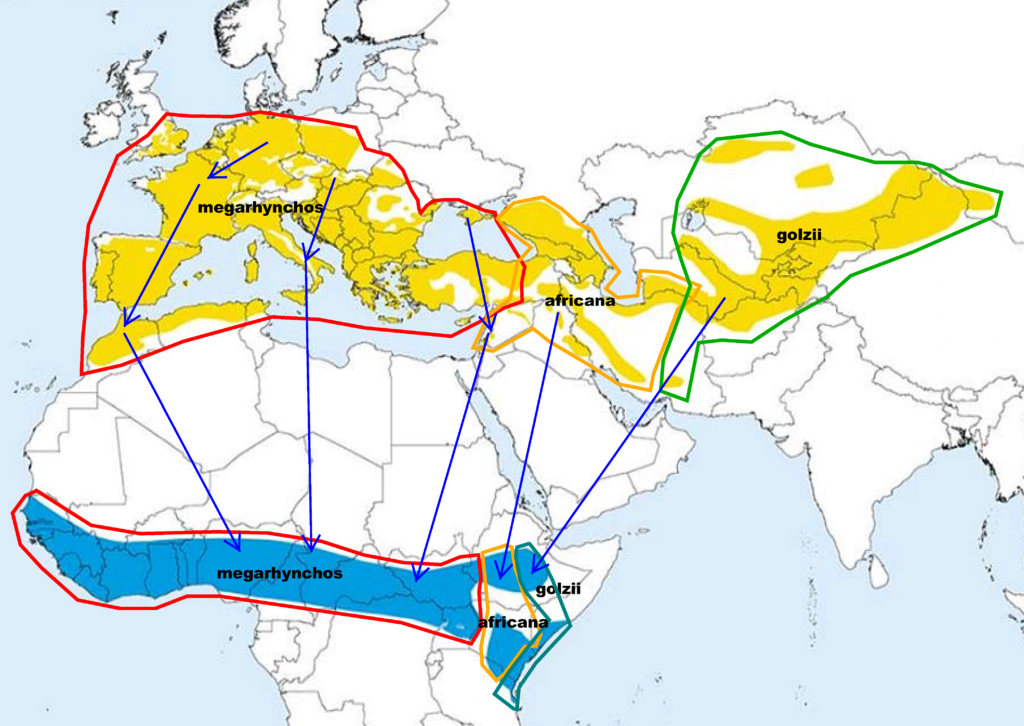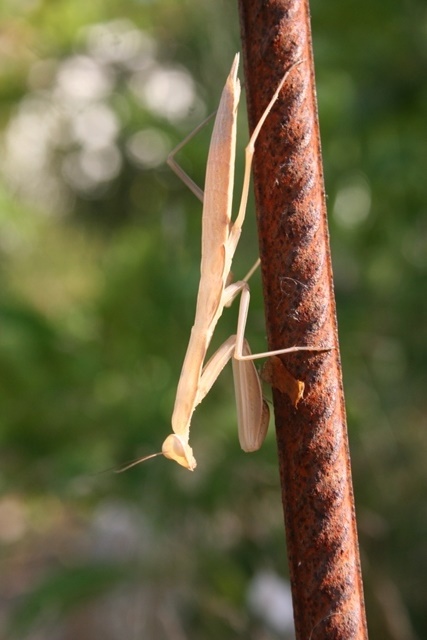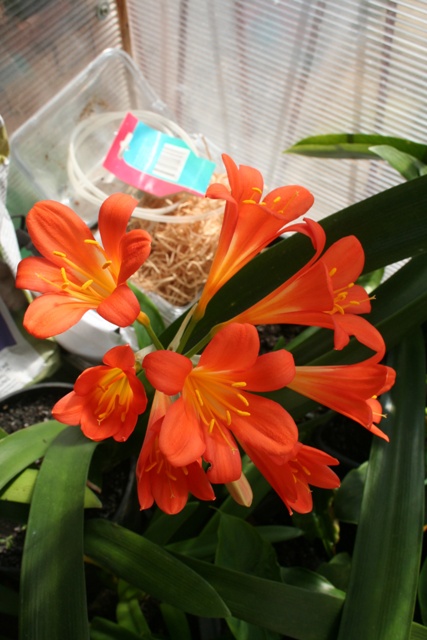New bug on the block
This week: Our first visitors are here; New bug on the block; Weather check; Fruit and flowers; Looking back;

Two of the kittens have been to the vets this week. They are close to 9 months old now and are definitely young adolescents.
On the one hand I felt sorry taking them for neutering. However although neutering is not as important for males as it is for females, there are benefits.
I see the obvious discomfort of two nearby males who are constantly caterwauling when a local female comes into season.
By neutering males it also curbs their aggressive behaviour towards other males.
Therefore the short term pain (both for me and them) in looking after a couple of ‘tinies’ after surgery, clearing up after “little accidents” and administering some pain relief, in the long term it will be to their benefit.
My other young male, Pongo has still not completely recovered from his brush with the car.
Because of that his turn will come in a couple of weeks.
In lovely warm sunshine, we all went for one of our usual meanders through the Olive Groves on Friday afternoon.
By today, just three days after surgery, they are running round as though nothing has happened.
Our first visitors are here
Out on the terrace on Monday at lunch time, I heard the unmistakable twittering of Swallows.
High up in the blue I could see a small flock of five, diving and swooping as they caught flies, of which we have an abundance at the moment.
As they carried out their aerobatic display, they gradually moved north and out of sight. These are the first of our summer migrants I have seen this year.
We have Swallows which return every year to nest and raise two broods in my neighbours out buildings, but these were not them.
I will have to wait a little longer for our local birds to arrive from South Africa.
After last year’s building work, I now have ample shady places and quiet corners. These are just the kind of location that Swallows like to nest.

It would be nice if a pair or pairs decided to build their nest in or around one of my buildings.
Then on Monday evening there was a Scops Owl calling from the Maquis between my Dol house and St Michael’s Church.
The metronome regular “Pip, pip, pip” call of the Scops is unmistakable and will be a night-time and even day-time sound until September.
Other migrants are probably already here, but with one exception I have not heard or seen them.
Or perhaps I’ve just not recognised their calls.
That exception is the Nightingale. They arrived overnight on the 1st April and as I did my morning check of the Top Orchard I heard the unmistakable song coming from a Bay tree at the very end of the orchard.
A second bird was answering from the other side of the ravine. As I came back to the house to get my camera, a third was singing in the Almond tree by the Citrus orchard.
By lunch time I could count eight different individuals calling from around my home.
If you are lucky enough to ever see a Nightingale, it is a small, drab red-brown coloured bird. However what the Nightingale lacks in colouring it makes up for in its song.
This is a recording I made at tea-time on Friday, using a Sony AX412 handheld digital recorder. In the background is one of our year-round resident Blackbirds.
A couple of years ago I found a dead Nightingale in the road at the entrance to my home.

These tiny birds, weighing just 20 grams migrate from Sub-Saharan Africa to Europe and back. They will find a mate, nest, raise chicks and then depart in early Autumn for their winter quarters.

New bugs on the block
On Thursday morning I was jumped on.
I had just closed the outer door of the greenhouse and was about to start watering when something landed on my ear. My first thought was that I had caught a spiders web as I had walked in.
I put my hand up to removed what ever it was that was crawling up my hair and looked to see what I had on my hand.

This looked like something prehistoric, straight from Jurassic Park.
I thought for a moment it was a stick insect, this is until it swivelled its head round and looked at me. Looking more closely I could see its front grasping arms, typical of the Mantis family
It looks like a piece of dead twig, a perfect camouflage against predators and disguise for a hunter.
I regularly see many different kinds of insects, some I have identified and some I recognise from past encounters, but have not yet found a name for them.
Generally my philosophy is that of “live and let live”.
If they don’t bite or attack me – think Tiger Mosquitoes here – then they are probably eating garden pests. So I put them somewhere deep in the garden to get on with what they do best.
I recognised this as a species of Mantis, but not one I have ever seen before here.
The tiny 5 mm long Mantis nymphs that I have in all the orchards, will soon be emerging from the soils, but this specimen was already 25 or 30 mm in length.

I grabbed my camera while he/she was on my hand. Then I had to change hands. My camera is a right hand operation device.
After a couple of minutes I put the Mantis into the Myrobalan cherry tree and a few minutes later when I checked, it was gone.

I found the little fella straight away in one of my Mediterranean Insects books, an Empusa fasciata, which doesn’t seem to have a common name.
These over-winter as young adults rather than nymphs, and I presume that it was in one of the plants that I brought into the greenhouse last autumn to protect them from the cold winter winds.
As the days lengthen and warm, it decided it was time to escape.
It eats flies, of which I have a lot at the moment, so I welcome it into the garden.
This Mantis is a completely new and quite distinctive species to me. It will grow about 75 mm in length, so it will more than double its current size.
I’ll be looking out for them in the future.
Weather check
It’s difficult to define seasons here in the Mediterranean.
We have the true Mediterranean climate of mild and wet winters and hot, dry summers. This is the classic climate for growing Olives and Grapes.
There is not the clear division into four seasons that more temperate climates experience, of Spring, Summer, Autumn and Winter. I wrote about the “Natural Year in Dol”, back in January.
Our “Spring” begins in early January and as different plants and trees wake from their rest period you have fruit developing on the Fig trees, whilst the Linden trees are barely showing their buds.
Spring will last until May, by which time we will already be experiencing our summer temperatures.

Many plants from the Mediterranean Basin grow, flower and fruit before the heat of summer arrives. Those plants which come into leaf early also tend to start losing their leaves in August, with the last into leaf.
My Flowering Amanogawa Cherry, is only just showing its blossom buds, but it will still have a few leaves on its branches in December.

On the red Myrobalan plum tree, the small round fruit are swelling. Although I lost a lot of the crop because of the recent cold snap, I think there may still be a reasonable crop this year.

The graphs from my weather station mirror this two season approach to seasonal weather. I graph the records for the wet season from November to March, and the dry summer from May until September rather than the less well defined four seasons.
Looking at the winter wet season which has just passed, we have had temperatures that are just below the average for much of the winter.

There have only been nine nights when the temperature has fallen below zero.

Generally the temperature has been below zero for just been for a couple of hours and not the whole night, and usually that has been between 05:30 and 07:00.
The lowest temperature that I have recorded was -2.4ºC, on one night in mid February.
The winter precipitation has been about average except for the last month.
The means that we are some 50 litres per square metre down on the winter average overall.

I am already having to irrigate plants.
Fruit and flowers
My orchards are unusual.
In addition to the fruit trees, of which I have around 45, I have also planted eye catching borders.
On the island where fruit trees are grown, be them olives or drupes, there is nothing else.
Around people’s homes, any land is used to cultivate vegetables, herbs and legumes. With perhaps some bulbs and the odd shrub around the edges.
Orchards around here are there to be productive. In places it is just a monoculture with the same green everywhere you look.

There has never been any landscape designing that uses either colour or form to please the eye, even in the areas that attract tourists.
Those who know me will know that I am unconventional!
So around where I have planted the fruit trees, I have also planted borders with architectural plants and shrubs.
These have been deliberately chosen to provide year round colour and interest.
In the photograph below are a shrub called Bachelor’s Button, Kerria japonica. This shrub is at it’s colourful best at the moment, however it will continue to flower from now until November.

Just behind the Kerria in this photograph is a Forsythia shrub.
This shrub is also in full bloom at the moment.
However unlike the Batchelor’s Button, once the Forsythia flowers die and the plant’s leaves appear, there will be no more yellow until next spring.
These shrubs and several more have been strategically placed.
Their placement is not just so I can see them, but also so my neighbours and people using the old path can see them as well.
The nicest compliment I have received is, “We love to see the colours in your garden”.
Whilst it is the large and showy plants and shrubs are the things which people notice the most, there are the often overlooked wild flowers, nestling amongst the grass. I have left a number of them in amongst the grass as I cut around them.

These brilliant white star shaped wild flowers are called the Star of Bethlehem, Ornithogalum umbellatum. They can be seen in all of the orchards and olive groves at the moment.
They grow in clumps from underground corms and are from the Asparagus family. These pretty flowers can be found across the Mediterranean Basin and in the Eastern states of the USA.

Whilst on the subject of Asparagus, I was foraging in the orchards this week, looking for wild asparagus tips. This easy meal was the result of just a few minutes work.

Butterflies are everywhere at the moment. When the sun shines, wherever you look, there are a multitude of big and small butterflies on the wing.

This is one of my Springwatch indicator species, the Swallowtail, Papilio machaon, here feeding on the Victoria Plum blossom.
This year, I first saw a Swallowtail on the 31st March and they will be flying until late September. NCG
Looking back – Week 13
This is the start of a new weekly section, with links to past issues of the blog.
2015/13 A quarter of the year has passed…..
2016/13 Holoportation ….. coming to Dol soon

2017/13 I need a longer zoom lens

2018/13 Dutch Dash

2019/13 Just thrice more!

2020/13 Loads of nula

3 Responses
Brian Homans
How lovely to have swallowtail butterflies around – you probably know that in the UK they are now only found in the Norfolk Broads. I was lucky enough to see and photograph one near Horsey Wind Pump a few years ago.
Elizabeth Blackledge
Hi Norman,
Glad to hear that the boys are back to normal again. Hope Pongo is continuing to get better.
We have had Brimstones and Red Admirals in the garden this week. Beautifully warm weather last week is set to go cold again next week so what that will do to everything that has come into flower and bud is a question. Tulips that were only supposed to be starting into flower by now have been and gone. Our front lawn is a colourful display of celandines, violets and daisies plus one or two border escapes of Chionodoxa and Anemone blanda … though not as many violets this year for some reason. The smell was wonderful but you needed to be standing in the right place with just the right amount of breeze to appreciate it. No weed and feed in this garden!
Happy Easter … stay safe and well.
Jeff Shadwell
Hi Norman,
Been a while mate – by the looks you have morphed from the weekly update to a full blown professional blog-ster!! Quite informative and impressive. Everyone doing ok here (Cheshire) Nick is now working for Astra-Zeneca (lot of world news going on about them) – both kids still doing well at school but are looking further afield at the end of it…. both are convinced they will be studying in NZ for uni – 2 more years for Leah & 4 for Simon. Leah wants to work with exotic animals and Simon still wants to play rugby for a top NZ team and ultimately the All Blacks. I am assisting Gareth (he’s moved down country to a more milder climate in Hereford) with his hydroponics business, its been going for half a year and I have become an equipment supplier for him!! Take care, all the best. Jeff